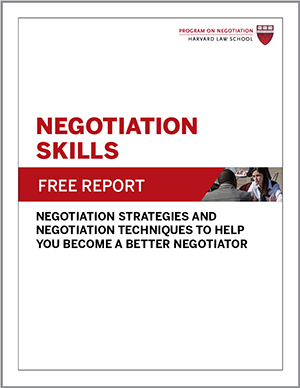
Skilled negotiators know that making strategic concessions at the right time can be an effective tactic in a negotiation. In this article, Deepak Malhotra, a professor at Harvard Business School and PON-affiliated faculty member, suggests four ways to make your concessions work to your best advantage.
1. Label Your Concessions
In negotiation, don’t assume that your actions will speak for themselves. Your counterparts will be motivated to overlook, ignore, or downplay your concessions. Why? To avoid the strong social obligation to reciprocate. As a result, it is your responsibility to label your concessions and make them salient to the other party—a responsibility that the manufacturer in the introductory example neglected.
When it comes to labeling, there are a few rules to follow. First, let it be known that what you have given up (or what you have stopped demanding) is costly to you. By doing so, you clarify that a concession was, in fact, made. For example, the manufacturer could have explained the effect of a 3 percent wage increase on his firm’s bottom line or discussed how difficult it would be for him to justify it to his board of directors.
Second, emphasize the benefits to the other side. My own research suggests that negotiators reciprocate concessions based on the benefits they receive, while tending to ignore how much others are sacrificing. One way for the manufacturer to highlight the benefits he was providing to the union would be to contrast his offer with those made by similar firms (assuming they were lower).
Third, don’t give up on your original demands too hastily. If the other side considers your first offer to be frivolous, your willingness to move away from it will not be seen as concessionary behavior. By contrast, your concessions will be more powerful when your counterpart views your initial demands as serious and reasonable. Accordingly, spend time legitimating your original offer and then use it as a reference point when labeling your concession. The manufacturer, for example, would have been wise to make concessions slowly. Eventually, he could point out that his final offer was closer to the union’s original demands than it was to his own.
2. Demand And Define Reciprocity
Labeling your concessions helps trigger an obligation to reciprocate, but sometimes your counterpart will be slow to act on that obligation. To increase the likelihood that you get something in return for your concession, try to explicitly—but diplomatically—demand reciprocity.
For example, consider the following negotiation between an IT services firm and a client. The client suggests that the IT firm’s cost estimates are unreasonably high; the IT firm’s project manager believes that the cost estimates are accurate (and perhaps conservative) given the complexity of the project and the short deadline. If the project manager is willing to make a concession, she might say: “This isn’t easy for us, but we’ve made some adjustments on price to accommodate your concerns. We expect that you are now in a better position to make some changes to the project deadlines. An extra month for each milestone would help us immeasurably.”
Notice that this statement achieves three goals. First, it labels the concession (“This isn’t easy for us, but we’ve made some adjustments …”). Second, it tactfully demands reciprocity (“We expect that you are now in a better position to make some changes …”). Third, it also begins to define the precise form that reciprocity should take (“An extra month for each milestone… “). While each of these elements is critical, negotiators often overlook the need to define reciprocity. Remember that no one understands what you value better than you do. If you don’t speak up, you’re going to get what your counterpart thinks you value or, worse, what is most convenient for your counterpart to give.
The strategy of demanding and defining reciprocity plays out in a variety of contexts; those who understand how to use it can profit from it immensely. A great example is a tactic consultants and contractors use. When a client praises her work, a smart consultant will quickly point out that the person who would really love to hear this praise is her boss (or other potential customers). In this way, she defines for the appreciative customer how best to reciprocate.
3. Make Contingent Concessions
One hallmark of a good working relationship is that parties don’t nickel-and-dime each other for concessions. Rather, each side learns about the interests and concerns of the other and makes good-faith efforts toward achieving joint gains.
Unfortunately, while fostering such norms is desirable, it is not always possible. Recently, one of my students in an executive education class explained that while he would be more than happy to engage in mutual give-and-take during his negotiations, he often has trouble doing so with his contractors and customers. Some are clearly untrustworthy or entirely self-interested. Such negotiators are likely to exploit his goodwill by refusing to reciprocate at all, much less in the way he has defined.
My advice to the executive: When trust is low or when you’re engaged in a one-shot negotiation, consider making contingent concessions. A concession is contingent when you state that you can make it only if the other party agrees to make a specified concession in return. For example, if the executive was renegotiating a service contract with a customer, he might suggest that a requested concession is impossible given the current contract but possible under certain conditions. He might say, “We can provide additional support but only if you agree to purchase some of the following additional services,” or, “This is literally the best we can do on price right now. But if you can adjust some of your demands, we might be able to reopen the price issue.”
Contingent concessions are almost risk-free. They allow you to signal to the other party that while you have room to make more concessions, it may be impossible for you to budge if reciprocity is not guaranteed. Keep in mind, however, that an over-reliance on contingent concessions can interfere with building trust. If you demand immediate compensation every time you make a concession, your behavior will be seen as self-serving rather than oriented toward achieving mutual satisfaction.
4. Make Concessions In Installments
Which of these scenarios would make you happier?
Scenario A:
While walking down the street, you find a $20 bill.
Scenario B:
While walking down the street, you find a $10 bill. The next day, on a different street, you find another $10 bill.
The total amount of money found is the same in each scenario—yet the vast majority of people report that Scenario B would make them happier. More generally, extensive research (beginning with the work of the late Stanford University professor Amos Tversky and the Princeton University professor and Nobel laureate Daniel Kahneman in the 1970s) demonstrates that while most of us prefer to get bad news all at once, we prefer to get good news in installments.
This finding suggests that the same concession will be more positively received if it is broken into installments. For example, imagine that you are negotiating the purchase of a house and that a wide gap exists between your initial offer and the seller’s asking price. You are willing to increase your offer by a maximum of $40,000. You will be more effective if you make two smaller concessions, such as $30,000 followed by $10,000, than if you make one $40,000 concession.
There are other reasons to make concessions in installments. First, most negotiators expect that they will trade offers back and forth several times, with each side making multiple concessions before the deal is done. If you give away everything in your first offer, the other party may think that you’re holding back even though you’ve been as generous as you can be. The manufacturer who offered a 3 percent wage increase to the employees’ union up front faced exactly this problem.
Installments may also lead you to discover that you don’t have to make as large a concession as you thought. When you give away a little at a time, you might get everything you want in return before using up your entire concession-making capacity. Whatever is left over is yours to keep—or to use to induce further reciprocity. In the real estate example, you might discover that the initial $30,000 increase in your offer was all that you needed to sign the deal!
Finally, making multiple, small concessions tells the other party that you are flexible and willing to listen to his needs. Each time you make a concession, you have the opportunity to label it and extract goodwill in return.
All of the above strategies are aimed at guaranteeing that the concessions you make are not ignored or exploited. It is important to note, however, that when someone refuses to reciprocate, the refusal often hurts her as much as the party who made the concession. Nonreciprocity sours the relationship, making it difficult for negotiators to trust each other or risk further concessions. Thus, effective negotiators ensure not only that their own concessions are reciprocated but also that they acknowledge and reciprocate the concessions of others.
How do you make concessions in a negotiation? Leave a comment.





Concession can be used as a tool to restart a broken negotiation. it can even be used as a strategy to break and restart again. depending upon the circumstances, and BATNA of both sides.
Great insights on negotiation strategies. Labeling concessions effectively communicates their significance, while demanding and defining reciprocity ensures a fair exchange. The concept of contingent concessions adds a layer of protection in situations where trust is low, preventing exploitation. Making concessions in installments aligns with human psychology, making them more positively received and allowing for flexibility in negotiations. It’s crucial to reciprocate concessions to build trust and maintain a positive relationship. Valuable tips for anyone navigating negotiations.
Truly a Golden Nugget.
While the information contained in the Daily Blog is valuable,
as a Realtor, this information provides excellent stepping stones in Getting to Yes.
Excellent advice to reaching better understandings, agreements and win-win outcomes.
Thank you for this post, this is an insightful and comprehensive article on the topic of concessions.